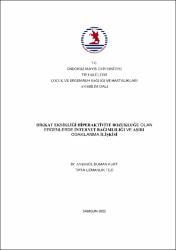Dikkat eksikliği hiperaktivite bozukluğu olan ergenlerde internet bağımlılığı ve aşırı odaklanma ilişkisi
Citation
Kurt, A.D. (2022). Dikkat eksikliği hiperaktivite bozukluğu olan ergenlerde internet bağımlılığı ve aşırı odaklanma ilişkisi. (Tıpta uzmanlık tezi). Ondokuz Mayıs Üniversitesi, Samsun.Abstract
Amaç: Bu çalışmanın amacı Dikkat Eksikliği Hiperaktivite Bozukluğu (DEHB) tanılı ergenlerde internet bağımlılığı (İB) ile aşırı odaklanma (AO) arasındaki ilişkiyi incelemektir. Yöntem: Araştırmamıza 11-17 yaş arası 65 DEHB tanılı ergen ve 16 sağlıklı ergen dahil edilmiştir. DEHB grubu; İB olan (Young İnternet Bağımlılığı Ölçeği (YİBÖ) ≥50) ve olmayan şeklinde ayrılarak istatistiksel analizler yapılmıştır. Araştırmaya katılan aileler çalışmacının hazırladığı sosyodemografik veri formunu, SNAP-IV Dikkat Eksikliği ve Hiperaktivite Bozukluğu için Belirti Değerlendirme Anketini, Aşırı Odaklanma Ölçeği Ebeveyn Formunu (AOÖ-ABF); ergenler ise, çalışmacının hazırladığı internet kullanımı formunu, YİBÖ‘yü, İnternet Oyun Bağımlılığı ÖlçeğiKısa Formunu, Aşırı Odaklanma Ölçeği Ergen Formunu (AOÖ-EF) doldurmuşlardır. DEHB ve kontrol grubundaki ergenlere Wisconsin Kart Eşleme Testi, Go No Go Testi, araştırmacı tarafından bilgisayar üzerinden uygulanmıştır. Bulgular: Araştırmamızda DEHB grubundaki 65 olgudan 21’inde (%32,3) İB saptanmıştır. DEHB+İB grubunda SNAP IV toplam puanları DEHB grubundan anlamlı olarak daha yüksek bulunmuştur. AOÖ-EF puan ortalamaları DEHB+İB grubunda DEHB grubundan daha yüksek elde edilse de istatistiksel olarak anlamlı düzeye ulaşmazken, kontrol grubundan anlamlı olarak daha yüksek bulunmuştur. AOÖ-ABF puan ortanca değerleri DEHB+İB grubunda hem DEHB hem de kontrol grubundan anlamlı olarak daha yüksek bulunmuştur. Lojistik regresyon analizlerinde AOÖ-EF toplam puanının bir birim artmasının İB riskini 1,52 kat artırdığı gösterilmiştir. Sonuç: DEHB’li ergenlerde İB puanları ve internet oyun oynama bozukluğu puanları arttıkça hem ergen tarafından bildirilen hem de ebeveyn tarafından gözlemlenen AO artmaktadır. Araştırma sonucumuz DEHB’li ergenlerde AO‘nun İB için önemli bir yordayıcı faktör olduğunu ortaya koymaktadır. Objective: The aim of this study is to examine the relationship between internet addiction (IA) and hyperfocus (HF) in adolescents with attention deficit hyperactivity disorder (ADHD). Method: 65 adolescents with ADHD and 16 healthy adolescents aged 11-17 years were included in our study. ADHD group; Statistical analyzes were performed by dividing them into those with IA (Young Internet Addiction Scale (YIBO)≥50) and those without. Families participating in the study used the sociodemographic data form prepared by the researcher, the SNAP-IV Symptom Assessment Questionnaire for Attention Deficit and Hyperactivity Disorder, the Hyperfocus Scale parent form (HS-PF); On the other hand, adolescents completed the Internet use form prepared by the researcher, YIAS, Internet Game Addiction Scale-Short Form, Hyperfocus Scale adolescent form (HS-AF). The Wisconsin Card Sorting Test and Go No Go Test were administered to the ADHD and control group adolescents via computer by the researcher. Results: In our study, IA was found in 21 (32.3%) of 65 patients in the ADHD group. SNAP IV total scores were found to be significantly higher in the ADHD+IA group than in the ADHD group. Although the mean HS-AF scores were higher in the ADHD+IA group than in the ADHD group, it did not reach a statistically significant level, but was found to be significantly higher than the control group. The median HS-PF scores were found to be significantly higher in the ADHD+IA group than in both the ADHD and control groups. In logistic regression analyzes, it has been shown that an increase of one unit in the HS-AF total score increases the risk of internet addiction 1.52 times. Conclusion: As IA scores and internet gaming disorder scores increase in adolescents with ADHD, HF both reported by the adolescent and observed by the parents increases. Our research result reveals that HF is an important predictive factor for IA in adolescents with ADHD.
















